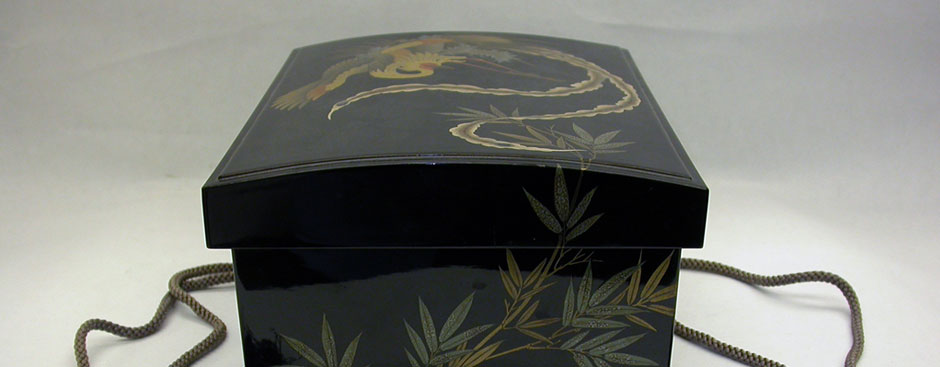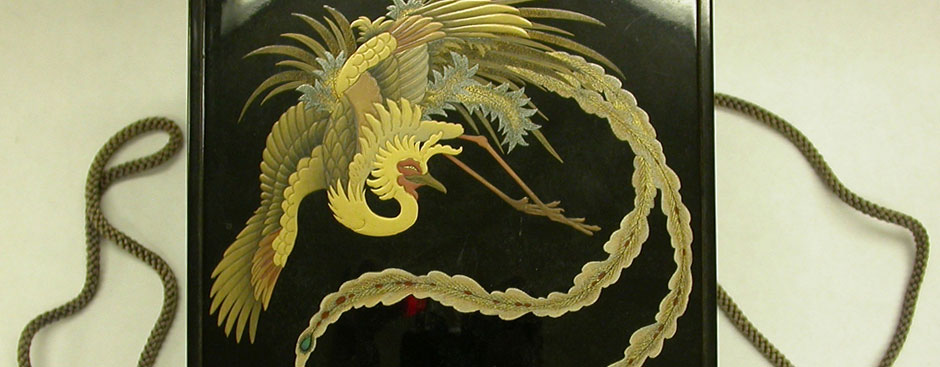Aizu-Nuri Lacquer Box
Angie Koo, Bryn Mawr College, Class of 2015
This Aizu-nuri lacquer box was donated to Bryn Mawr College by Elizabeth Gray Vining, class of 1923. After World War II, Vining was appointed as the tutor to the Japanese Crown Prince Akihito (the reigning Emperor) for approximately four years. Her appointment as tutor represented a break in tradition for the Imperial Family: not only did Vining not speak Japanese but, traditionally, the Crown Prince is educated by groups of chamberlains ("Vining Tutors Crown," 1951). As tutor, Vining was tasked with teaching the Crown Prince English and Western customs. The two developed a close relationship and Vining remembered him fondly after returning to the US (Woo, 1999). During her employment to the Crown Prince, Vining was gifted this lacquer box along with many other items by the Imperial Family.
Although the lacquer box appears quite simple, its designs tell a detailed and symbolic narrative. Prominently featured on the lid of the box is a large phoenix accompanied by sprigs of bamboo that also appear on the sides of the box. These motifs have been rendered with gold powder through a Japanese lacquering technique known as maki-e, which adds considerable value to this object. Originating in the Heian period (794-1185), maki-e is a design technique that involves adhering fine metal particles, such as gold and other colored powders onto the lacquered surface (makie 蒔絵, 2001). The gold particles add vibrancy to the phoenix and bamboo springs, heavily contrasting their depictions with the sleek black lacquer background.
Phoenixes, known as hō-ō in Japanese, are a mythical bird with a conglomeration of features such as "a bird's beak, a swallow's jaw, and a snake's neck" (houou 鳳凰, 2001). Although the phoenix was originally a Chinese symbol known as fenghuang, it was imported to Japan in the Asuka period (538-794). In Japan, phoenixes became a popular decorative element and were commonly used to embellish textiles, mirrors, chests, and lacquerware. The phoenix is considered a sacred and pure bird in Japan. It is also thought that phoenixes only appear in times of peace and that its appearance marks the beginning of a new era in history. Associated with such positive connotations, the phoenix also came to represent benevolent imperial reign. Furthermore, phoenixes are linked with themes of rebirth, prosperity, and longevity in Japan. Bamboo, the other motif, symbolizes "strength combined with flexibility" for its ability to bend but not break, and "powerful progress and ascendancy" due to its fast growth (Bess, 2001). These implicit ideas and images of the phoenix and bamboo play a major role in ascertaining the significance of the Aizu-nuri lacquer box.
As a gift from the Imperial Family to Elizabeth Vining, the lacquer box ties Japan with the West. Contextually, this exchange took place not long after World War II; Japan's Emperor had only recently surrendered to the Allied Forces. Along with the destruction caused by the bombings of Hiroshima and Nagasaki, Japan was still reeling from the war and its defeat. In breaking tradition and hiring Elizabeth Vining to become the Crown Prince's tutor, the Imperial Family is taking steps to modernize and westernize Japan so that it can be seen as a powerful nation. The same analogy is present in the lacquer box; it carries implicit messages about the resiliency of the Imperial Family and the nation and conveys hope for recovery following the devastations of World War II.
The lacquerware box is a product of a nearly 400-year-old traditional lacquer industry in the Aizu region of Fukushima, Japan. Lacquerware from this region is well known and highly prized; it is distinguished by its colorful and gold-relief decorations. What started out as a local industry in the 16th century was able to flourish as each successive ruler of the region promoted the craft and its refinement. During the Edo period (1603-1868), Aizu exported its lacquerware to China and Holland. The industry was not without problems, however. During the late Edo period a civil war broke out between the ruling Tokugawa shogunate and other political factions that nearly decimated the Aizu region and its lacquer industry. Fortunately, during the subsequent Meiji Restoration, the Aizu lacquer industry rebuilt itself and became the backbone to the rebuilding of the Aizu region ("The History of" ).
The Aizu lacquer industry and the Aizu region are connected to the recent triple disasters of 3.11 that struck northeastern Japan. Positioned in the western region of Fukushima prefecture and more than 100km from the Fukushima Daiichi power plant, Aizu was not as heavily affected by the earthquake, tsunami, or nuclear meltdown as eastern Fukushima. This has fortunately mostly spared the residents of the Aizu region and the lacquer industry. The Aizu Lacquer Union has even recently accepted new students into its training school and has begun recruiting for its next group of trainees. Furthermore, in late 2012 the Aizu region hosted a lacquerware festival, titled the Aizu Urushi Art Festival, for the third consecutive year. The theme of the festival focused on the future of the lacquer industry and lacquer as a medium for traditional artisans as well as modern artists. There are hopes to continue this festival for many more years in order to preserve and showcase the region's rich lacquerware history (Masuda, 2012).
This seemingly simple Aizu-nuri lacquer box housed in Bryn Mawr College's Special Collections is a fascinating object not only because it is a physical exchange from the Japanese Imperial Family to Elizabeth Gray Vining, but also for the implicit messages inscribed onto the decorations of the box, the ties it has to the Aizu lacquer industry, and the ties it has to past and present disasters. The lacquer box is representative of the Imperial Family and to a larger extent, Japan. The box and its industry has gone through wars and disasters that mirror the experiences the nation has undergone. Yet, both the industry and Japan have remained resilient, looking towards a hopeful future.

